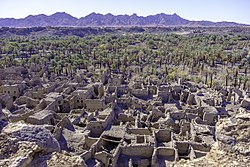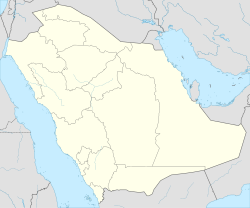Khaybar
Oasis in Medina Province, Saudi Arabia From Wikipedia, the free encyclopedia
Khaybar[note 1] (Arabic: خَيْبَر, IPA: [ˈxajbar]) is an oasis in Medina Province, Saudi Arabia, situated some 153 kilometres (95 mi) north of the city of Medina. Prior to the arrival of Islam in the 7th century, the area had been inhabited by Arabian Jewish tribes until it fell to Muslims under Muhammad during the Battle of Khaybar in 628 CE.
Khaybar
خَيْبَر | |
|---|---|
 Ancient ruins of Khaybar | |
| Coordinates: 25°41′55″N 39°17′33″E | |
| Country | Saudi Arabia |
| Region | Al Madinah Region |
| established | 6th century BC |
| Time zone | UTC+3 (AST) |
History
Summarize
Perspective

Bronze Age
This section needs expansion. You can help by adding to it. (February 2025) |
Pre-Islamic
Before the advent of Islam in the 7th century CE, indigenous Arabs and Jews made up the population of Khaybar, but when Jewish settlement in northern Arabia began is unknown.[note 2] In 567, Khaybar was invaded and purged of its Jewish inhabitants by the Ghassanid Arab Christian king Al-Harith ibn Jabalah. He later freed the captives upon his return to the Levant. A brief account of the campaign is given by Ibn Qutaybah,[1] which may also be mentioned in the sixth-century Harran inscription.[2][3]Khaybar Oasis was completely surrounded by a massive wall in pre-Islamic times, similar to other large walled oases in northwestern Arabia and dates back to the Bronze Age, between 2250 and 1950 BCE it would have been needed for protection against surrounding nomadic groups of populations from the desert, potentially carrying out raids on oasis settlements.[4]
7th century
As late as the 7th century, Khaybar was still inhabited by Jews, who pioneered the cultivation of the oasis.[5]
Military campaigns of Muhammad
Expedition of Fadak
In 627, Muhammad ordered the Expedition of Fadak to attack the Bani Sa‘d bin Bakr tribe because Muhammad received intelligence they were planning to help the Jews of Khaybar.[6] In this expedition one person was captured by Muslims, and the rest of the tribe fled.[7]
Battle of Khaybar
The Battle of Khaybar took place in May/June 628.[8] The Jewish Banū Naḍīr of Medina, who claimed to be descendants of Aaron the priest, owned lands in Khaybar and had castles, fortresses and weapons there. After Muhammad expelled them from Medina in 625, their leaders moved to their estates in Khaybar to prepare for war against Muhammad and to recruit the aid of other non-Muslim Arab tribes. Muhammad first sent disguised guests to the homes of the leaders of Banū Naḍīr, who killed their hosts. Muhammad's victory over the Jews of Khaybar in the subsequent battle was also aided by the distance of the settlements and their castles from one another, the absence of co-ordination between the fighting forces, the death of the leader Sallām ibn Mishkam and a Jew who showed the Muslims the secret entrances to one of the fortresses. The castles of Khaybar had tunnels and passages, which in wartime enabled the besieged to reach water sources outside the castles.[9] Between 16 and 18 Muslims and 93 Jews were killed.[10]
Aftermath
Captives of war and slaves from other countries were brought to Khaybar, and the people of Hejaz became more accustomed to agriculture. Jews continued to live in the oasis for several years until they were finally expelled by Caliph Umar, who decided to expel the Jews of Khaybar in 642 under the pretense that before his death, Muhammad had commanded that two religions could not exist simultaneously in the Hejaz.[9]
Expulsion of Jews
During the reign of Caliph Umar (634–644), the Jewish community of Khaybar was transported alongside the Christian community of Najran to the newly-conquered regions of Syria and Iraq. Umar also forbade non-Muslims to reside in the Hejaz for longer than three days.[11] Since then, the Jews of Khaybar travelled around many areas throughout the Islamic Empire as artisans and merchants and they are still referred to in documents from the Middle Ages.[12]
Benjamin of Tudela
Benjamin of Tudela was a Jew from Tudela, in the Kingdom of Navarre, who travelled to Persia and Arabia in the 12th century. He visited and described Khaybar and neighboring Tayma sometime around 1170 and mentioned those places as Jewish habitations.[13]
Khaybar in culture and politics
Folklore
Khaybar is referred to in various traditions outside the Hejaz. The Makhamra family, a Palestinian extended family who lives in the city of Yatta, in the southern Hebron Hills, claims ancestry from the Jews of Khaybar. Over the years, there have been reports of locals in Yatta and its vicinity continuing to observe various Jewish rituals. In the late 19th century, peasants from Meithalun, present-day northern West Bank, associated a nearby ruin locally known as Khirbet Kheibar with an unnamed Jewish king and his daughter who, according to their tradition, resided in the area. Some scholars have suggested tying those two traditions to the expulsion of Jews from Khaybar and their settlement in the region.[14]
Contemporary antisemitic use
The tale of the Jews of Khaybar being vanquished and driven out has been revived in recent decades by the Palestinian Islamic militant group Hamas, who have used it as a political slogan in its propaganda against Israel.[14] The slogan has also been used by some at pro-Palestine protests and other anti-Israel events, as well as online.[15][16]
Economy
Historically, Khaybar is known for growing dates. The dates raised in the region were generally exported to Medina.[17]
Climate
| Climate data for Khaybar | |||||||||||||
|---|---|---|---|---|---|---|---|---|---|---|---|---|---|
| Month | Jan | Feb | Mar | Apr | May | Jun | Jul | Aug | Sep | Oct | Nov | Dec | Year |
| Mean daily maximum °C (°F) | 21.6 (70.9) |
24.6 (76.3) |
27.8 (82.0) |
32.6 (90.7) |
36.2 (97.2) |
38.9 (102.0) |
39.3 (102.7) |
39.3 (102.7) |
38.3 (100.9) |
34.2 (93.6) |
27.6 (81.7) |
22.8 (73.0) |
31.9 (89.5) |
| Mean daily minimum °C (°F) | 9.1 (48.4) |
7.6 (45.7) |
12.2 (54.0) |
16.0 (60.8) |
20.7 (69.3) |
24.0 (75.2) |
24.7 (76.5) |
24.8 (76.6) |
22.6 (72.7) |
18.4 (65.1) |
13.0 (55.4) |
9.0 (48.2) |
16.8 (62.3) |
| Average precipitation mm (inches) | 9 (0.4) |
3 (0.1) |
14 (0.6) |
12 (0.5) |
5 (0.2) |
0 (0) |
0 (0) |
1 (0.0) |
0 (0) |
4 (0.2) |
17 (0.7) |
8 (0.3) |
73 (2.9) |
| Source: Climate-data.org | |||||||||||||
See also
References
External links
Wikiwand - on
Seamless Wikipedia browsing. On steroids.

